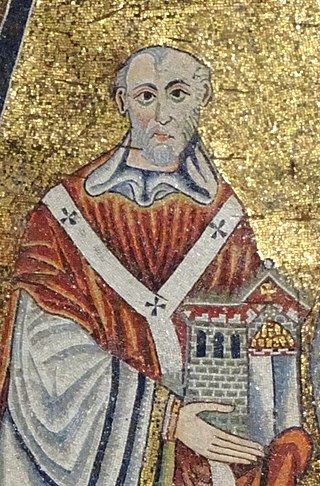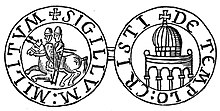
Bernard of Clairvaux, O. Cist., venerated as Saint Bernard, was an abbot, mystic, co-founder of the Knights Templar, and a major leader in the reform of the Benedictines through the nascent Cistercian Order.

Pope Anastasius IV, born Corrado Demetri della Suburra, was head of the Catholic Church and ruler of the Papal States from 8 July 1153 to his death in 1154. He is the most recent pope to take the name "Anastasius" upon his election.

Pope Innocent II, born Gregorio Papareschi, was head of the Catholic Church and ruler of the Papal States from 14 February 1130 to his death in 1143. His election as Pope was controversial, and the first eight years of his reign were marked by a struggle for recognition against the supporters of Anacletus II. He reached an understanding with King Lothair III of Germany, who supported him against Anacletus, and whom he crowned as Holy Roman Emperor. Innocent went on to preside over the Second Council of the Lateran.

Year 1133 (MCXXXIII) was a common year starting on Sunday of the Julian calendar.

Lothair III, sometimes numbered Lothair II and also known as Lothair of Supplinburg, was Holy Roman Emperor from 1133 until his death. He was appointed Duke of Saxony in 1106 and elected King of Germany in 1125 before being crowned emperor in Rome. The son of the Saxon count Gebhard of Supplinburg, his reign was troubled by the constant intriguing of the Hohenstaufens, Duke Frederick II of Swabia and Duke Conrad of Franconia. He died while returning from a successful campaign against the Norman Kingdom of Sicily.

Pope Lucius II, born Gherardo Caccianemici dal Orso, was head of the Catholic Church and ruler of the Papal States from 9 March 1144 to his death in 1145. His pontificate was notable for the unrest in Rome associated with the Commune of Rome and its attempts to wrest control of the city from the papacy. He supported Empress Matilda's claim to England in the Anarchy, and had a tense relationship with King Roger II of Sicily.

Roger II or Roger the Great was King of Sicily and Africa, son of Roger I of Sicily and successor to his brother Simon. He began his rule as Count of Sicily in 1105, became Duke of Apulia and Calabria in 1127, then King of Sicily in 1130 and King of Africa in 1148.
The Second Council of the Lateran was the tenth ecumenical council recognized by the Catholic Church. It was convened by Pope Innocent II in April 1139 and attended by close to a thousand clerics. Its immediate task was to neutralise the after-effects of the schism which had arisen after the death of Pope Honorius II in 1130 and the papal election that year that established Pietro Pierleoni as the antipope Anacletus II.
Anacletus II, born Pietro Pierleoni, was an antipope who ruled in opposition to Pope Innocent II from 1130 until his death in 1138. After the death of Pope Honorius II, the college of cardinals was divided over his successor. Unusually, the election was entrusted to eight cardinals, who elected Papareschi. A larger body of cardinals then elected Pierleoni, which led to a major schism in the Roman Catholic Church. Anacletus had the support of most Romans, including the Frangipani family, and Innocent was forced to flee to France. North of the Alps, Innocent gained the crucial support of the major religious orders, in particular Bernard of Clairvaux's Cistercians, the Abbot of Cluny Peter the Venerable; and Norbert of Xanten, the Archbishop of Magdeburg who established the Premonstratensians and held a high rank in the court of the German Emperor Lothar III.
Victor IV was an antipope for a short time, from March to 29 May 1138.
Uberto Lanfranchi was the Cardinal-deacon of Santa Maria in Via Lata, then the Cardinal-priest of San Clemente, and finally the Archbishop of Pisa.

Ex commisso nobis, more commonly known as the Bull of Gniezno, was a papal bull issued on July 7, 1136 by Pope Innocent II. The bull split off the Bishopric of Gniezno from the Archbishop of Magdeburg. From a historical perspective, the bull is especially important as it contains the earliest written record of the Polish language. Slavic language scholar Aleksander Brückner called the document "złota bulla języka polskiego".
Engelbert III, a member of the Rhenish Franconian House of Sponheim, was Margrave of Istria from 1124 until his death.
Pandulf of Pisa was a twelfth-century Italian cardinal, and biographer of several contemporary popes. He was a native of Rome. He was a nephew of Cardinal Hugo of Alatri. Under Pope Paschal II, and probably with the patronage of his uncle, Pandulf held the post of ostiarius at the papal court. It is deduced from his detailed description of the election of Pope Gelasius II on 24 January 1118 that he was present. On his coronation day, 10 March 1118, Pope Gelasius II elevated him to the rank of Lector and Exorcist. Pope Calixtus II ordained him a subdeacon.

According to the Catholic Church, a Church Council is ecumenical ("world-wide") if it is "a solemn congregation of the Catholic bishops of the world at the invitation of the Pope to decide on matters of the Church with him". The wider term "ecumenical council" relates to Church councils recognised by both Eastern and Western Christianity.

The 1130 papal election was convoked after the death of Pope Honorius II and resulted in a double election. Part of the cardinals, led by Cardinal-Chancellor Aymeric de la Chatre, elected Gregorio Papareschi as Pope Innocent II, but the rest of them refused to recognize him and elected Cardinal Pietro Pierleoni, who took the name of Anacletus II. Although Anacletus had the support of the majority of the cardinals, the Catholic Church considers Innocent II as the legitimate Pope, and Anacletus II as Antipope.
Gilo of Toucy, also called Gilo of Paris or Gilo of Tusculum, was a French poet and cleric. A priest before he became a monk at Cluny, he was appointed cardinal-bishop of Tusculum sometime between 1121 and 1123. He served as a papal legate on four occasions: to Poland and Hungary around 1124, to Carinthia in 1126, to the Crusader states in 1128 or 1129 and to Aquitaine from 1131 until 1137. He took the side of the Antipope Anacletus II in the papal schism of 1130 and was deposed as cardinal-bishop by the Second Lateran Council in 1139.

The 1143 papal election followed the death of Pope Innocent II and resulted in the election of Pope Celestine II.
An incomplete list of events in 1139 in Italy:
Desiderius was a Roman Catholic Cardinal, and Cardinal-priest of the titulus of S. Prassede in Rome.












